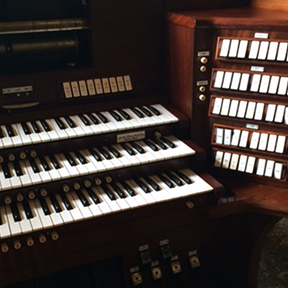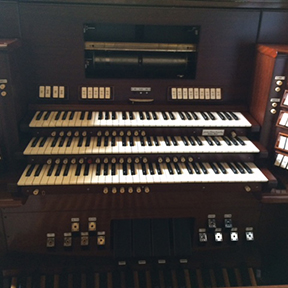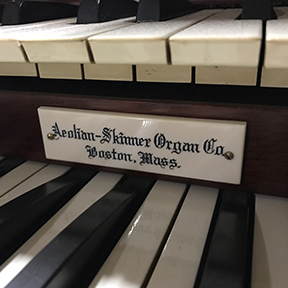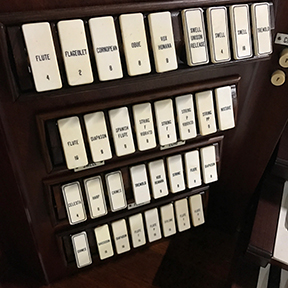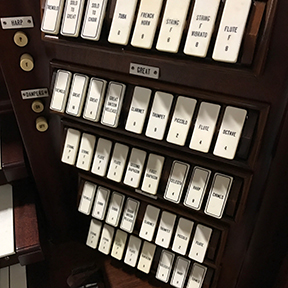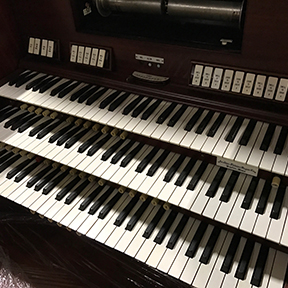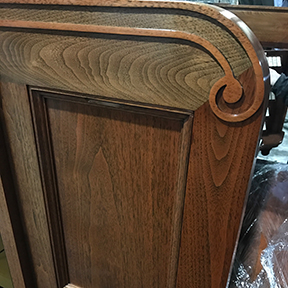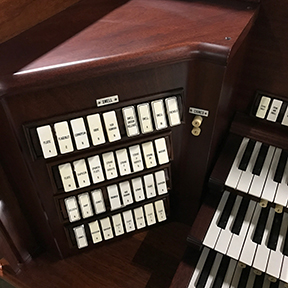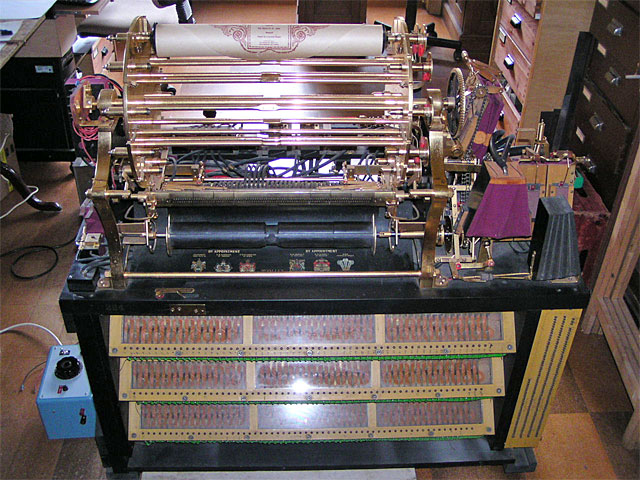Stoneleigh - Organ & Concertola
History of Aeolian-Skinner Opus 878
Aeolian-Skinner Opus 878 was originally designed in 1931 and installed as a residence organ, in the Charles W. Nichols residence in West Orange, New Jersey; known as “Pleasantdale Chateau,” a half-timber Norman revival mansion situated within a 40-acre estate with formal gardens. Mr. Nichols was a captain of industry; and like many of his contemporaries was part of a vast multi-generational family business empire. Many of these families also had grand residence organs installed by some of the country’s top organ building firms.
Some years later, Pleasantdale had changed hands and the organ had fallen into disuse and disrepair. It was discovered by Curt Mangel, who removed the organ with the intention of installing it in another residence. The organ was eventually sold to Fred Cramer of Pittsburgh, Penn., who set about systematically rebuilding the organ. It is only fitting that an instrument with such a pedigree should eventually find its way to Stoneleigh, one of the great family estates of Philadelphia’s Main Line, all the more now that it is to be home to the Organ Historical Society.
The original installation included a player mechanism in the console to operate the organ by way of paper player rolls. Notably, it also included a Concertola, a unique player mechanism with a selector from which the user could choose from ten player rolls housed within the unit. The organ also comes with a significant collection of several hundred player rolls. With the aid of solid-state technology we will be able to record all of the rolls so that the pieces, once recorded into the solid-state capture system, can be replayed over and over again without constantly loading and unloading the paper rolls, which are so easy to damage.
As Rollin Smith states at the beginning of his book Pipe Organs of the Rich and Famous (published by the OHS Press):
“In the 1920s, there were [several] different kinds of pipe organs: church organs, which everyone knew; theater organs, which vast audiences of movie-goers knew; and residence organs, which only the wealthy knew. Residence organs were built for the stately homes of the carriage trade and few outsiders ever heard them, or, for that matter, could imagine their capabilities.”
Once installed at Stoneleigh Aeolian-Skinner Opus 878 will be a local and national landmark and provide endless opportunities for the Organ Historical Society to engage a wide variety of audiences, for the first time in the instrument’s life. (This instrument is slated for installation by Emery Brothers in 2017)
Some years later, Pleasantdale had changed hands and the organ had fallen into disuse and disrepair. It was discovered by Curt Mangel, who removed the organ with the intention of installing it in another residence. The organ was eventually sold to Fred Cramer of Pittsburgh, Penn., who set about systematically rebuilding the organ. It is only fitting that an instrument with such a pedigree should eventually find its way to Stoneleigh, one of the great family estates of Philadelphia’s Main Line, all the more now that it is to be home to the Organ Historical Society.
The original installation included a player mechanism in the console to operate the organ by way of paper player rolls. Notably, it also included a Concertola, a unique player mechanism with a selector from which the user could choose from ten player rolls housed within the unit. The organ also comes with a significant collection of several hundred player rolls. With the aid of solid-state technology we will be able to record all of the rolls so that the pieces, once recorded into the solid-state capture system, can be replayed over and over again without constantly loading and unloading the paper rolls, which are so easy to damage.
As Rollin Smith states at the beginning of his book Pipe Organs of the Rich and Famous (published by the OHS Press):
“In the 1920s, there were [several] different kinds of pipe organs: church organs, which everyone knew; theater organs, which vast audiences of movie-goers knew; and residence organs, which only the wealthy knew. Residence organs were built for the stately homes of the carriage trade and few outsiders ever heard them, or, for that matter, could imagine their capabilities.”
Once installed at Stoneleigh Aeolian-Skinner Opus 878 will be a local and national landmark and provide endless opportunities for the Organ Historical Society to engage a wide variety of audiences, for the first time in the instrument’s life. (This instrument is slated for installation by Emery Brothers in 2017)
Specification of Aeolian-Skinner Opus 878
GREAT
8 1st Diapason
8 2nd Diapason
8 String F
8 String P
8 Flute F
8 Flute P
4 Octave
4 High Flute
2 Piccolo
8 Trumpet
8 Clarinet
Tremolo
Chimes
Harp
Celesta
8 1st Diapason
8 2nd Diapason
8 String F
8 String P
8 Flute F
8 Flute P
4 Octave
4 High Flute
2 Piccolo
8 Trumpet
8 Clarinet
Tremolo
Chimes
Harp
Celesta
CHOIR
8 2nd Diapason
8 String F
8 String P
8 Flute F
8 Flute P
4 High Flute
2 Piccolo
8 Trumpet
8 Clarinet
Tremolo
Chimes
Harp
Celesta
8 2nd Diapason
8 String F
8 String P
8 Flute F
8 Flute P
4 High Flute
2 Piccolo
8 Trumpet
8 Clarinet
Tremolo
Chimes
Harp
Celesta
SWELL
16 Deep Flute
8 Diapason
8 Spanish Flute
8 String F
8 String F Vibrato
8 String PP
4 High Flute
2 Flageolet
V Mixture
8 Cornopean
8 Oboe
8 Vox Humana
Tremolo
Chimes
Celesta
16 Deep Flute
8 Diapason
8 Spanish Flute
8 String F
8 String F Vibrato
8 String PP
4 High Flute
2 Flageolet
V Mixture
8 Cornopean
8 Oboe
8 Vox Humana
Tremolo
Chimes
Celesta
ECHO
8 Diapason
8 String
8 Flute
8 Vox Humana
Tremolo
SOLO
8 Philomela
8 Gamba
8 Gamba Celeste
8 Tuba
8 French Horn
8 Diapason
8 String
8 Flute
8 Vox Humana
Tremolo
SOLO
8 Philomela
8 Gamba
8 Gamba Celeste
8 Tuba
8 French Horn
PEDAL
32 Resultant
16 Diapason
16 Violone
16 Deep Flute F
16 Deep Flute
8 Flute F
8 Flute P
Chimes
32 Resultant
16 Diapason
16 Violone
16 Deep Flute F
16 Deep Flute
8 Flute F
8 Flute P
Chimes
GREAT
8 1st Diapason
8 2nd Diapason
8 String F
8 String P
8 Flute F
8 Flute P
4 Octave
4 High Flute
2 Piccolo
8 Trumpet
8 Clarinet
Tremolo
Chimes
Harp
Celesta
8 1st Diapason
8 2nd Diapason
8 String F
8 String P
8 Flute F
8 Flute P
4 Octave
4 High Flute
2 Piccolo
8 Trumpet
8 Clarinet
Tremolo
Chimes
Harp
Celesta
CHOIR
8 2nd Diapason
8 String F
8 String P
8 Flute F
8 Flute P
4 High Flute
2 Piccolo
8 Trumpet
8 Clarinet
Tremolo
Chimes
Harp
Celesta
8 2nd Diapason
8 String F
8 String P
8 Flute F
8 Flute P
4 High Flute
2 Piccolo
8 Trumpet
8 Clarinet
Tremolo
Chimes
Harp
Celesta
SWELL
16 Deep Flute
8 Diapason
8 Spanish Flute
8 String F
8 String F Vibrato
8 String PP
4 High Flute
2 Flageolet
V Mixture
8 Cornopean
8 Oboe
8 Vox Humana
Tremolo
Chimes
Celesta
16 Deep Flute
8 Diapason
8 Spanish Flute
8 String F
8 String F Vibrato
8 String PP
4 High Flute
2 Flageolet
V Mixture
8 Cornopean
8 Oboe
8 Vox Humana
Tremolo
Chimes
Celesta
ECHO
8 Diapason
8 String
8 Flute
8 Vox Humana
Tremolo
SOLO
8 Philomela
8 Gamba
8 Gamba Celeste
8 Tuba
8 French Horn
8 Diapason
8 String
8 Flute
8 Vox Humana
Tremolo
SOLO
8 Philomela
8 Gamba
8 Gamba Celeste
8 Tuba
8 French Horn
PEDAL
32 Resultant
16 Diapason
16 Violone
16 Deep Flute F
16 Deep Flute
8 Flute F
8 Flute P
Chimes
32 Resultant
16 Diapason
16 Violone
16 Deep Flute F
16 Deep Flute
8 Flute F
8 Flute P
Chimes
Slideshow of Console Photos
Concertola
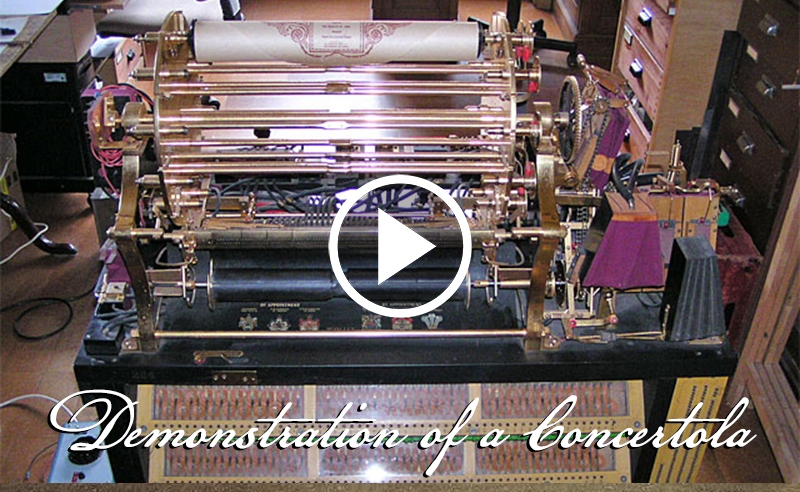
▶︎ Concertola Demonstration
A demonstration of a Concertola similar to the one being installed at Stoneleigh.
A demonstration of a Concertola similar to the one being installed at Stoneleigh.
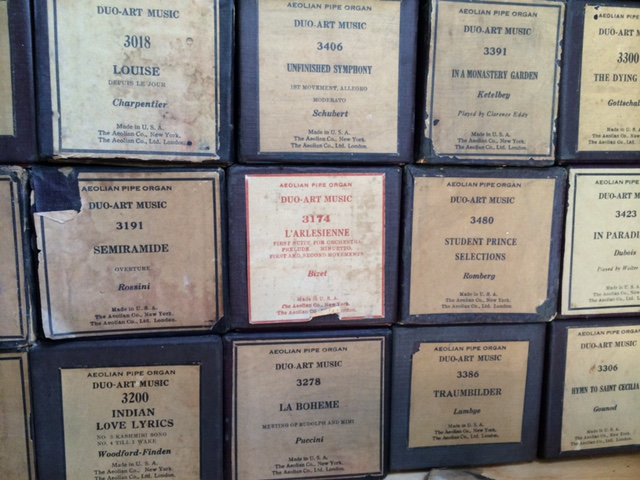
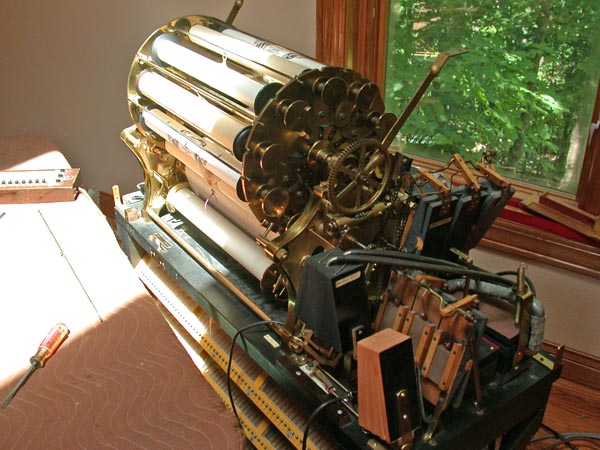
The Concertola was designed to play as many as ten Duo-Art rolls. The Concertola was operated by a hand control, a small box-like mechanism with individual switches for each title that was available, connected to a long small cable, so that it could be placed on a table some distance away, and the “master” or “mistress” of the house would then sit nearby in an easy chair and summon music by pressing the switch for the desired selection.
▶︎ Console
Fred Haas at the Aeolian-Skinner console.
Fred Haas at the Aeolian-Skinner console.

